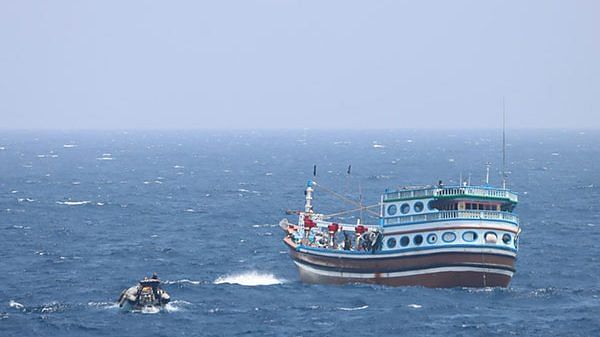Thank you dear subscribers, we are overwhelmed with your response.
Your Turn is a unique section from ThePrint featuring points of view from its subscribers. If you are a subscriber, have a point of view, please send it to us. If not, do subscribe here: https://theprint.in/subscribe/
Public fear has long been a powerful tool in politics. Leaders exploit it to consolidate authority, justify war, or mobilize against perceived enemies. But this tactic does not stop at domestic borders; it extends into foreign policy, as a tool of transnational influence.
Today, the Indian Ocean Region (IOR) is often cast in alarmist terms. Commentators warn of encirclement by powers like China and Turkey. China’s “String of Pearls” – a network of maritime facilities from its coast to Port Sudan – is portrayed as a creeping threat. Turkey’s naval footprint in Somalia, Sudan, and IOR islands is similarly described as neo-Ottoman ambition. The tone is often one of dread: What if these countries are building military footholds to dominate the region?
While vigilance is important, panic is not. Military bases may once have offered strategic value. But in a world shaped by cyber warfare, economic interdependence, and soft power diplomacy, their utility is far more complicated. The question is not whether rivals are setting up overseas outposts – it is whether such moves are effective, sustainable, or even worth fearing.
The Evolution of Forward Presence
Foreign military bases date back centuries from Roman forts to British coaling stations to Cold War-era U.S. airfields. The logic was simple: proximity enhances control. Bases allowed empires to secure trade routes, monitor rivals, and project force.
But warfare has evolved. Today, influence is projected via satellites, long-range missiles, and digital propaganda. Trade leverage and media narratives often outweigh boots on the ground. Against this backdrop, physical bases – costly and politically sensitive – seem increasingly blunt instruments.
Counting Costs
Maintaining foreign bases is expensive. It requires troops, logistics, infrastructure, and constant political negotiation. Host nations often demand equipment, aid, or diplomatic support. Some hedge by engaging multiple powers – Sri Lanka and the Maldives are examples.
There is also the risk of backlash. From Okinawa to Diego Garcia, bases have sparked protests and calls for removal. These are not just operational concerns they reflect political and reputational costs.
Consider the U.S., which operates about 750 bases in over 80 countries. Yet it still faces cyberattacks, economic competition, and domestic extremism. If 750 bases do not guarantee security, what number would?
Tactical Gains, Strategic Limits
Bases do offer certain advantages. They enable faster deployments, regional surveillance, and reassurance to allies. China’s base in Djibouti supports African investments. Turkey’s facilities in Somalia expand its presence, at least symbolically.
But these returns are limited. Bases depend on the goodwill of host governments, which can change with elections or unrest. They are vulnerable in conflict and politically fragile in peacetime. Their perceived permanence often hides their transactional nature.
More importantly, influence no longer requires occupation. China’s Belt and Road Initiative (BRI), despite its flaws, has achieved more strategic reach through ports, railways, and loans than any military asset. India’s influence in Bhutan or Nepal stems from shared culture, electricity grids, and education – not airstrips. Turkey’s growing appeal in the Arab world owes more to television than naval deployments.
The Age of Influence Without Occupation
In today’s geopolitics, projecting power no longer requires physical presence. Leverage increasingly stems from economic ties, cultural influence, and technological interdependence – tools that are less provocative, more adaptable, and often more enduring.
Once seen as optional, soft power is now essential – building trust, shaping perception, and opening doors. Military bases, by contrast, invite suspicion, provoke resentment, and require heavy investment. In an era driven by narrative, credibility often outweighs coercion.
Panic vs. Perspective
Should we be concerned about Chinese and Turkish bases in the IOR? Yes – but with perspective. These developments deserve scrutiny, not hysteria. IOR countries are not passive pawns. They hedge, extract concessions, and recalibrate relationships to serve their own interests.
Sri Lanka, for instance, welcomed Chinese-funded ports while maintaining close ties with India. The Maldives has shifted between Indian and Chinese alignments. Even Somalia, long seen as fragile, engages multiple players to maximize its advantage.
Recognizing this agency is key. A multipolar world demands analysis that includes local politics, historical ties, and domestic priorities – not just satellite images and naval estimates.
A Call for Strategic Maturity
Military bases still have value. But they are no longer the centrepiece of power projection. Geopolitical strategy must shift from territorial anxiety to relational strategies built on trade, trust, and technology.
Reacting to every naval base or port lease with alarm diverts attention from deeper currents shaping global affairs: economic dependency, media influence, and political narrative control. These are the real battlefields.
Fear grabs attention, but it rarely builds durable strategy. The challenge is not only to counter rivals, but to do so without copying their paranoia. Calm thinking, not reflexive panic, should guide global policy.
These pieces are being published as they have been received – they have not been edited/fact-checked by ThePrint.



This is a very insightful and well-argued article. I particularly appreciate the way you have challenged conventional wisdom about the nature of power in the 21st century.
The distinction drawn between the old paradigm of physical military presence and the new realities of economic, cultural, and technological influence is both timely and thought-provoking.